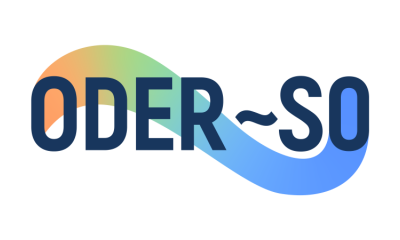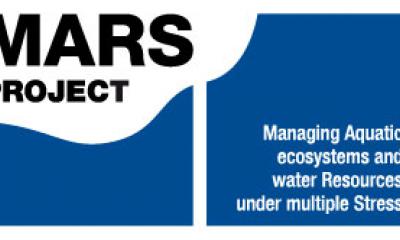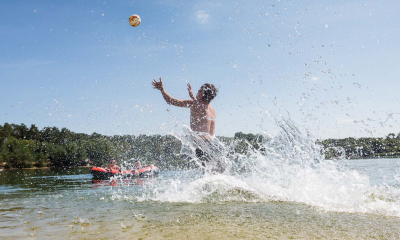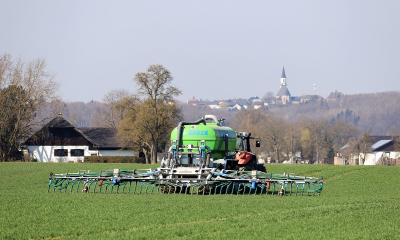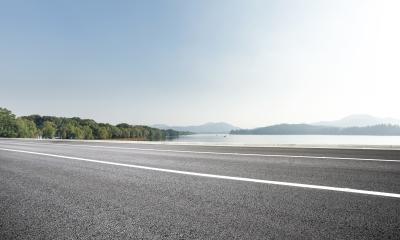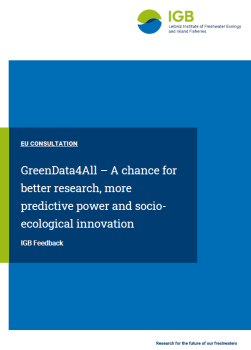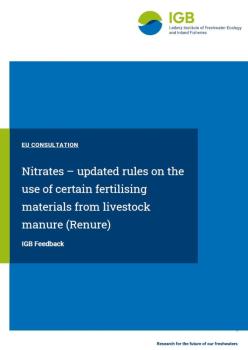River System Modelling
Group profile

Nutrient fluxes in the Danube river basin modelled with MONERIS. | Image: Markus Venohr / IGB
Our working group explores the quantification of nutrient fluxes in large river systems. Large gradients of anthropogenic activities, human induced pressures and their effects on aquatic ecosystems arise from the source to the mouth and between different river systems. This enables us to derive interrelations that often remain hidden at smaller scales (e.g. consideration of a single brook). Our analyses and models are designed to integrate interrelations for the entire catchment area, forming the scientific basis for tackling application-oriented issues.
The working group, consisting of geographers, geo-ecologists and biologists, deals with the following thematic areas:
Process-oriented assessment and quantification of sources and drivers of nutrient and sediment emissions – Human activities change landscapes as well as matter and water fluxes. How have they changed from early industrialisation to the present, and what future impacts can we expect from global change?
Modelling of instream transformation and retention processes – Empirical analysis of the bio-availability of nutrients and the modelling of eutrophication processes. What spatio-temporal patterns do nutrient emissions exhibit? To what extent do amount and distribution of emissions, shading, water temperature and flow regulation govern eutrophication within large river systems?
Analysis of the effects of altered hydrology, increased sediment and nutrient emissions, and degraded hydromorphology on aquatic ecosystems – How do these stressors interact, and from which point do they have a negative impact on the ecological condition of freshwaters? Do all stressors have to be reduced to an equal extent, or can good ecological status be achieved by removing just one stressor?
Consideration of rivers as socio-ecological systems – What is the connection between the quality of aquatic ecosystems and their appeal for leisure activities? What dynamics and spatial distribution apply to recreational uses? How can recreational use, objectives of nature/environmental protection and management aspects be intelligently combined?
Methods and model development – Knowledge from the different thematic areas and scales is incorporated into the development of various models: nutrient emissions, retention and loads (MONERIS), growth and transport of algae (PhytoBasinRisk), multi-stressor analysis at the EU level (Scenario Analysis Tool - SAT).

Orthophotomap of Kharaa river as an example for biomonitoring of riparian and river meadow vegetation (degraded river meadow, river bank erosion and river less impacted islands). | Image: Martin Oczipka

Research in the headwaters of Kharaa river as an example for water quality monitoring of natural reference conditions. | Photo: L. Menzel
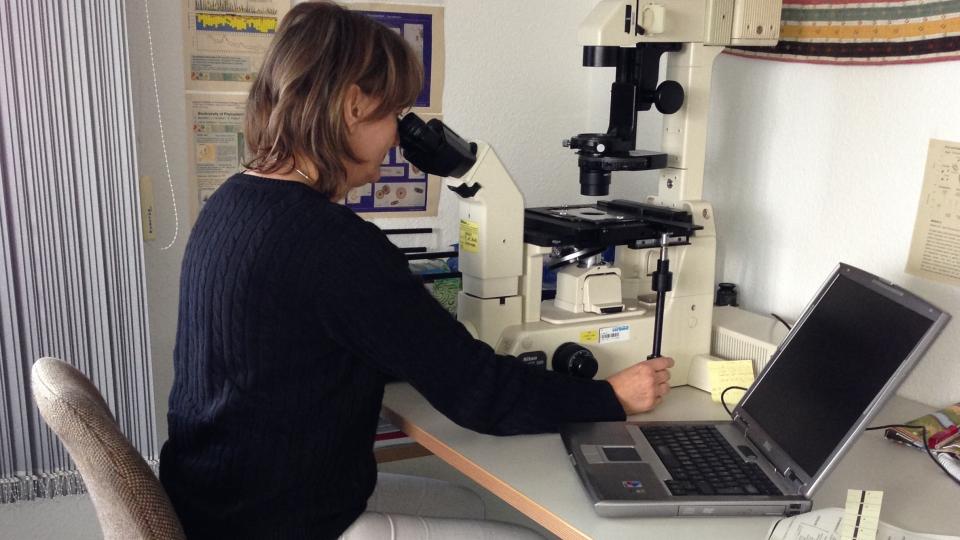
Using a microscope to analyse water samples. | Photo: Jürgen Hofmann / IGB
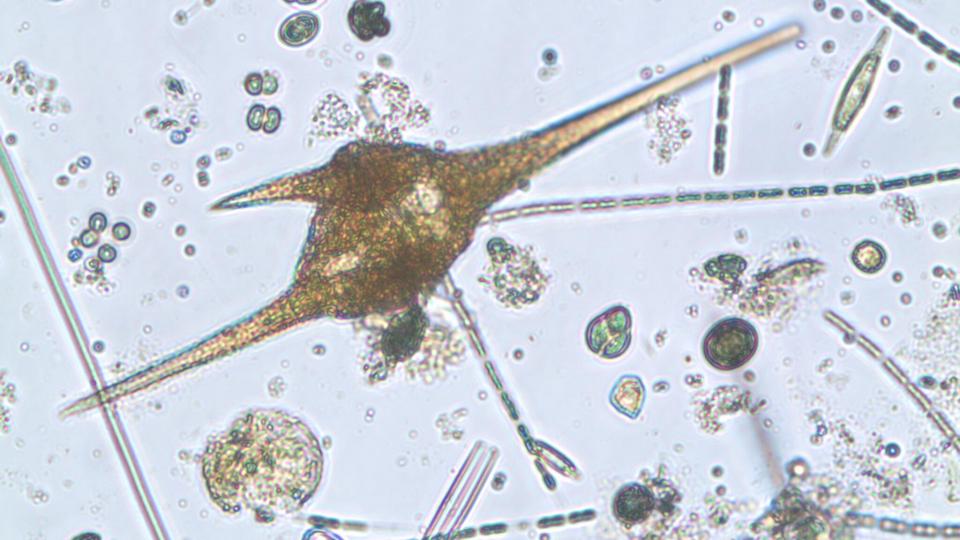
Planktonic algae under the microscope – centre: dinoflagellate Ceratium furcoides. | Image: Ute Mischke / IGB
Taking soil samples in the Sao Francisco catchment in Brazil. | Photo: Peter Fischer / IGB
Group members
Alumni
Mathias Gadegast
Gilles Jean-Louis
Dr. Stephanie Natho
Dr. Simone Podschun
Publications
Publications
2025
November 2025
Hong Hanh Nguyen; Christian Schürings; Ellen A.R. Welti; Andrea Sundermann; Michael Trepel; Andreas Gericke; Markus Venohr
Stricter reductions of nutrient pollution support riverine community recovery in degraded catchments
Journal of Environmental Management. - 395(2025), Art. 127909
March 2025
O. Shumilova; A. Sukhodolov; N. Osadcha; A. Oreshchenko; G. Constantinescu; S. Afanasyev; M. Koken; V. Osadchyi; B. Rhoads; K. Tockner; M. T. Monaghan; B. Schröder; J. Nabyvanets; C. Wolter; O. Lietytska; J. van de Koppel; N. Magas; S. C. Jähnig; V. Lakisova; G. Trokhymenko; M. Venohr; V. Komorin; S. Stepanenko; V. Khilchevskyi; S. Domisch; M. Blettler; P. Gleick; L. De Meester; H.-P. Grossart
Environmental effects of the Kakhovka Dam destruction by warfare in Ukraine
Science. - 387(2025)6739, 1181-1186
February 2025
Markus Venohr; Christine Beusch; Tobias Goldhammer; Hanh Hong Nguyen; Simone Podschun; Claudia Schmalsch; Christian Wolter
Spatial distribution of nicotine concentrations in Berlin’s surface waters and their potential sources
Environmental Science and Pollution Research. - 32(2025), 6784–6803
2024
January 2025
Benjamin Schmidt; Max Eysholdt; Mareike Fischer; Peter Kreins; Astrid Krüger; Ralf Kunkel; Hong Hanh Nguyen; Björn Tetzlaff; Michael Trepel; Markus Venohr; Frank Wendland; Tim Wolters; Maximilian Zinnbauer
June 2024
Björn Tetzlaff; Ralf Kunkel; Max Eysholdt; Hong Hanh Nguyen; Markus Venohr; Tim Wolters; Maximilian Zinnbauer; Frank Wendland
Modelling Current-State N- and P-Fluxes into Surface Waters in Germany
Water. - 16(2023)13, Art. 1872
October 2023
Gilles Jean-Louis; Michelle Eckhardt; Simone Podschun; Judith Mahnkopf; Markus Venohr
Estimating daily bicycle counts with Strava data in rural and urban locations
Travel Behaviour and Society. - 34(2024), Art. 100694
2023
January 2024
Andrea Ghermandi; Johannes Langemeyer; Derek Van Berkel; Fulvia Calcagni; Yaella Depietri; Lukas Egarter Vigl; Nathan Fox; Ilan Havinga; Hieronymus Jäger; Nina Kaiser; Oleksandr Karasov; Timon McPhearson; Simone Podschun; Ana Ruiz-Frau; Michael Sinclair; Markus Venohr; Spencer A. Wood
January 2024
Maximilian Zinnbauer, Max Eysholdt, Martin Henseler, Frank Herrmann, Peter Kreins, Ralf Kunkel, Hanh Nguyen, Björn Tetzlaff, Markus Venohr, Tim Wolters, Frank Wendland
Quantifizierung aktueller und zukünftiger Nährstoffeinträge und Handlungsbedarfe für ein deutschlandweites Nährstoffmanagement: AGRUM-DE
July 2023
Autor*innen: Sami Domisch, Jörn Geßner, Sabine Hilt, Sonja Jähnig, Sibylle Schroer, Matthias Stöck, Markus Venohr, Christian Wolter; Redaktion: Johannes Graupner
IGB-Feedback zur Fortschreibung der NBS2030: Biodiversität und Ökosysteme der Binnengewässer stärker berücksichtigen
June 2023
Ke Chen; Doerthe Tetzlaff; Tobias Goldhammer; Jonas Freymueller; Songjun Wu; Aaron Andrew Smith; Axel Schmidt; Guodong Liu; Markus Venohr; Chris Soulsby
Synoptic water isotope surveys to understand the hydrology of large intensively managed catchments
Journal of Hydrology. - 623(2023), Art. 129817
December 2022
Hong Hanh Nguyen; Markus Venohr; Andreas Gericke; Andrea Sundermann; Ellen A.R.Welti; Peter Haase
Dynamics in impervious urban and non-urban areas and their effects on run-off, nutrient emissions, and macroinvertebrate communities
Landscape and Urban Planning. - 231(2023), Art. 104639
2022
January 2023
Daniel Hering; Willem Kaijser; Julian Enss; Carina Jadjewski; Reinhard Rust; Markus Venohr
December 2022
Andreas Gericke ; Martin Pusch ; Markus Venohr ; Cristian Mihai Adamescu ; Constantin Cazacu ; Tim Borgs ; Barbara Stammel ; Zorica Srđević ; Gabriela Costea
Synthesis and visualisation of crosssectoral benefits in scenarios: [Chapter 2.4]
Ecosystem services in floodplains and their potential to improve water quality/Hrsg.: Stäps, Julia ; Gericke, Andreas ; Lungu, Adrian ; Stammel, Barbara, Katholische Universität Eichstätt-Ingolstadt [u.a.], 2022. - S. 92-102
December 2022
Authors: Tobias Goldhammer, Sabine Hilt, Michael Hupfer, Jan Köhler, Jörg Lewandowski, Stephanie Spahr, Markus Venohr. Editorial team: Johannes Graupner
Nutrients – Action plan for better management: IGB Feedback [25 August 2022]
July 2022
Martin Tschikof; Andreas Gericke; Markus Venohr; Gabriele Weigelhofer; Elisabeth Bondar-Kunze; Ute Susanne Kadene; Thomas Hein
The potential of large floodplains to remove nitrate in river basins: the Danube case
Science of the Total Environment. - 843(2022), Art. 156879
May 2022
Hong Hanh Nguyen; Andreas Gericke; Markus Venohr
Importance of different imperviousness measures for predicting runoff and nutrient emissions from non-urban and urban land-uses at large spatial coverage
Journal of Environmental Management. - 315(2022), Art. 115105
2021
January 2022
Nguyen, H.H. and Venohr, M.
Sewer leakage: first nationwide estimate of pollution leaking from urban systems, Germany: [newsalert]
October 2021
Nora Meyer; Malwina Schafft; Benjamin Wegner; Christian Wolter; Robert Arlinghaus; Markus Venohr; Goddert von Oheimb
A day on the shore - Ecological impacts of non-motorised recreational activities in and around inland water bodies
Journal for Nature Conservation. - 64(2021), Art. 126073
July 2021
Andreas Gericke; Judith Mahnkopf; Markus Venohr
Catchments of German surface water bodies
Hydrological Processes. - 35(2021)7, Art. e14272
April 2021
Jan U. Lemm; Markus Venohr; Lidija Globevnik; Kostas Stefanidis; Yiannis Panagopoulos; Jos van Gils; Leo Posthuma; Peter Kristensen; Christian K. Feld; Judith Mahnkopf; Daniel Hering; Sebastian Birk
Multiple stressors determine river ecological status at the European scale: towards an integrated understanding of river status deterioration
Global Change Biology. - 27(2021)9, 1962-1975
March 2021
Hong Hanh Nguyen; Aaron Peche; Markus Venohr
Modelling of sewer exfiltration to groundwater in urban wastewater systems: a critical review
Journal of Hydrology. - 596(2021), Art. 126130
February 2021
Barbara Stammel; Christine Fischer; Bernd Cyffka; Christian Albert; Christian Damm; Alexandra Dehnhardt; Helmut Fischer; Francis Foeckler; Lars Gerstner; Tim G. Hoffmann; Janette Iwanowski; Hans D. Kasperidus; Kathrin Linnemann; Dietmar Mehl; Simone A. Podschun; Marin Rayanov; Stephanie Ritz; Andrea Rumm; Mathias Scholz; Christiane Schulz‐Zunkel; Julia Thiele; Markus Venohr; Christina von Haaren; Martin T. Pusch; Marion Gelhaus
Assessing land use and flood management impacts on ecosystem services in a river landscape (Upper Danube, Germany)
River Research and Applications. - 37(2021)2, 209-220
February 2021
Hong Hanh Nguyen; Markus Venohr
Harmonized assessment of nutrient pollution from urban systems including losses from sewer exfiltration: a case study in Germany
Environmental Science and Pollution Research. - 28(2021), 63878–63893
2020
January 2023
Benjamin Schmidt; Ute Kuhn; Michael Trepel; Mareike Fischer; Astrid Krüger; Peter Kreins; Maximilian Zinnbauer; Max Eysholdt; Frank Wendland; Ralf Kunkel; Björn Tetzlaff; Tim Wolters; Markus Venohr; Hong Hanh Nguyen
Bestimmung der Nährstoffbelastung und des Handlungsbedarfs in den deutschen Flussgebieten
Wasser und Abfall. - 04(2022), S. 20-28
January 2021
Benjamin Schmidt; Ute Kuhn; Dr. Michael Trepel; Peter Kreins; Maximilian Zinnbauer; Max Eysholdt; Bernhard Osterburg; Philipp Löw; Prof. Dr. Frank Wendland; Dr. Frank Herrmann; Dr. Ralf Kunkel; Dr. Björn Tetzlaff; Tim Wolters; Dr. Markus Venohr; PhD. Hanh Nguyen
Modellansatz zur Bestimmung der Nährstoffbelastung und ihrer Reduktion in allen deutschen Flussgebieten
Wasser und Abfall. - 22(2020)1-2, S. 33-38
January 2021
Author of this report: Dr. Jochem Kail; List of partners involved in the project: Prof. Dr. Daniel Hering; Dr. Jochem Kail; Dr. Markus Venohr; Dr. Jérémy Piffady; Prof. Dr. Ir Jan Vermaat
OSCAR – Optimising the configuration of woody riparian buffer strips along riversto enhance biodiversity and ecosystem services: final project report ; reporting template
January 2021
Sebastian Birk; Daniel Chapman; Laurence Carvalho; Bryan M. Spears; Hans Estrup Andersen; Christine Argillier; Stefan Auer; Annette Baattrup-Pedersen; Lindsay Banin; Meryem Beklioğlu; Elisabeth Bondar-Kunze; Angel Borja; Paulo Branco; Tuba Bucak; Anthonie D. Buijse; Ana Cristina Cardoso; Raoul-Marie Couture; Fabien Cremona; Dick de Zwart; Christian K. Feld; M. Teresa Ferreira; Heidrun Feuchtmayr; Mark O. Gessner; Alexander Gieswein; Lidija Globevnik; Daniel Graeber; Wolfram Graf; Cayetano Gutiérrez-Cánovas; Jenica Hanganu; Uğur Işkın; Marko Järvinen; Erik Jeppesen; Niina Kotamäki; Marijn Kuijper; Jan U. Lemm; Shenglan Lu; Anne Lyche Solheim; Ute Mischke; S. Jannicke Moe; Peeter Nõges; Tiina Nõges; Steve J. Ormerod; Yiannis Panagopoulos; Geoff Phillips; Leo Posthuma; Sarai Pouso; Christel Prudhomme; Katri Rankinen; Jes J. Rasmussen; Jessica Richardson; Alban Sagouis; José Maria Santos; Ralf B. Schäfer; Rafaela Schinegger; Stefan Schmutz; Susanne C. Schneider; Lisa Schülting; Pedro Segurado; Kostas Stefanidis; Bernd Sures; Stephen J. Thackeray; Jarno Turunen; María C. Uyarra; Markus Venohr; Peter Carsten von der Ohe; Nigel Willby; Daniel Hering
Impacts of multiple stressors on freshwater biota across spatial scales and ecosystems
Nature Ecology & Evolution. - 4(2020), S. 1060–1068
December 2020
Autoren: Andreas Gericke; Markus Venohr
OSCAR – Optimising the configuration of woody riparian buffer strips along rivers to enhance biodiversity and eco-system services (BiodivERsA2015-108)
August 2020
Barbara Stammel; Christine Fischer; Bernd Cyffka; Christian Albert; Christian Damm; Alexandra Dehnhardt; Helmut Fischer; Francis Foeckler; Lars Gerstner; Tim G. Hoffmann; Janette Iwanowski; Hans D. Kasperidus; Kathrin Linnemann; Dietmar Mehl; Simone A. Podschun; Marin Rayanov; Stephanie Ritz; Andrea Rumm; Mathias Scholz; Christiane Schulz‐Zunkel; Julia Thiele; Markus Venohr; Christina von Haaren; Martin T. Pusch; Marion Gelhaus
Assessing land use and flood management impacts on ecosystem services in a river landscape (Upper Danube, Germany)
River Research and Applications. 2020;1–12
July 2020
Markus Venohr; Judith Mahnkopf; Andreas Gericke
Räumliche Verteilung und Quellen von gelösten und partikulären Phosphoreinträgen in Deutschland
Wertermittlungsforum. - 38(2020)1, S. 18-27
March 2020
Andreas Gericke; Hong Hanh Nguyen; Peter Fischer; Jochem Kail; Markus Venohr
2019
January 2020
Jörg Freyhof; Mark Gessner; Hans-Peter Grossart; Sabine Hilt; Sonja Jähnig; Jan Köhler; Thomas Mehner; Martin Pusch; Markus Venohr; Christian Wolter
November 2019
Leoni Mack; Hans Estrup Andersen; Meryem Beklioglu; Tuba Bucak; Raoul-Marie Couture; Fabien Cremona; M. Teresa Ferreira; Michael G. Hutchins; Ute Mischke; Eugenio Molina-Navarro; Katri Rankinen; Markus Venohr; Sebastian Birk
The future depends on what we do today: projecting Europe's surface water quality into three different future scenarios
Science of the Total Environment. - 668(2019), S. 470-484
October 2019
Jörg Freyhof; Mark Gessner; Hans-Peter Grossart; Sabine Hilt; Sonja Jähnig; Jan Köhler; Thomas Mehner; Martin Pusch; Markus Venohr; Christian Wolter
August 2019
Martin T. Pusch; Simone A. Podschun; Christian Albert; Christian Damm; Alexandra Dehnhardt; Christine Fischer; Helmut Fischer; Francis Foeckler; Marion Gelhaus; Lars Gerstner; Janette Iwanowski; Tim G. Hoffmann; Dietmar Mehl; Marin Rayanov; Stephanie Ritz; Andrea Rumm; Mathias Scholz; Barbara Stammel; Julia Thiele; Markus Venohr
Ökosystemleistungen von Flussauen bewerten: der RESI-Ansatz
Auenmagazin. - 16(2019), S. 6-10
May 2019
Andreas Gericke; Jens Kiesel; Detlef Deumlich; Markus Venohr
April 2019
Yiannis Panagopoulos; Kostas Stefanidis; Marta Faneca Sanchez; Frederiek Sperna Weiland; Rens van Beek; Markus Venohr; Lidija Globevnik; Maria Mimikou; Sebastian Birk
January 2019
Laurence Carvalho; Eleanor B. Mackay; Ana Cristina Cardosa; Annette Baattrup-Pedersen; Sebastian Birk; Kirsty L. Blackstock; Gábor Borics; Angel Borja; Christian K. Feld; Maria Teresa Ferreira; Lidija Globevnik; Bruna Grizzetti; Sarah Hendry; Daniel Hering; Martyn Kelly; Sindre Langaas; Kristian Meissner; Yiannis Panagopoulos; Ellis Penning; Josselin Rouillard; Sergi Sabater; Ursula Schmedtje; Bryan M. Spears; Markus Venohr; Wouter van de Bund; Anne Lyche Solheim
Protecting and restoring Europe's waters: an analysis of the future development needs of the Water Framework Directive
Science of the Total Environment. - 658(2019), S. 1228-1238
2018
January 2019
Simone A. Podschun; Christian Albert; Gabriela Costea; Christian Damm; Alexandra Dehnhardt; Christine Fischer; Helmut Fischer; Francis Foeckler; Marion Gelhaus; Lars Gestner; Volkmar Hartje; Tim G. Hoffmann; Lena Hornung; Janette Iwanowski; Hans Kasperidus; Kathrin Linnemann; Dietmar Mehl; Marin Rayanov; Stephanie Ritz; Andrea Rumm; Achim Sander; Matthias Schmidt; Mathias Scholz; Christiane Schulz-Zunkel; Barbara Stammel; Julia Thiele; Markus Venohr; Christina von Haaren; Marcus Wildner; Martin Pusch
January 2019
Peter Fischer; Andreas Gericke; Markus Venohr
Further development of the MONERIS model with particular focus on the application in the Tisza River Basin, for the implementation of JOINTISZA project: (project code: DTP1-152-2.1)
35, 51 S.
January 2019
Autoren: A. Gericke; M. Matranga; M. Venohr; P. Carl
Klimawandel und Wetteranomalien: Bewertung von Agrar-Umwelt-Maßnahmen ; Schlussbericht, Dezember 2018 ; Laufzeit:1.10.2015-30.6.2018
V, 83 S.
January 2019
Rafaela Schinegger; Lisa Schülting; Stefan Schmutz; Anne Lyche Solheim; Sebastian Birk; Christian Feld; Daniel Hering; Marijn Kuijper; Clara Chrzanowski; Tom Buijse; Angel Borja; Markus Venohr; Lidija Globevnik
MARS recommendations on how to best assess and mitigate impacts of multiple stressors in aquatic ecosystems: duration: February 1st, 2014 - January 31th, 2018
50 S.
December 2018
Roshni Arora; Marco Toffolon; Klement Tockner; Markus Venohr
Thermal discontinuities along a lowland river: the importance of urban areas and lakes
Journal of Hydrology. - 564(2018), S. 811-823
May 2018
Markus Venohr; Sebastian Birk; Vanessa Bremerich; Andreas Gericke; Lidija Globevnik; Maja Koprivsek; Judith Mahnkopf; Yiannis Panagopoulos; Luka Snoj; Marta Faneca Sanchez; Kostas Stefanidis; Frederiek Sperna Weiland
Managing aquatic ecosystems and water resources under multiple stress: MARS project ; deliverable 7.2-1: MARS suite of tools II ; scenario analysis tool (SAT) ; report on data, scientific methods and tool implementation
3, 93, 106 S.
May 2018
ed. by Sebastian Birk; Daniel Hering. Contributers: Erik Jeppesen Angel Borja; Stefan Schmutz; Vit Kodes; Steve Ormerod; Jenica Hanganu; Marijn Kuijper; Tom Buijse; Tiina Noges; Markus Venohr; Ana Cristina Cardoso; Christine Argillier; Meryem Beklioglu; Laurence Carvalho; Anna Lyche Solheim; Yiannis Panagopoulos; Marko Järvinen; Lidija Globevnik; Teresa Ferreira; Helena Alves; Helena Mühlmann; Rafaela Schinegger; Jo-Ann Pitt; Edith Hödl; Corina Boscomea
Managing aquatic ecosystems and water resources under multiple Stress: MARS project ; final report ; duration: Februar 1st 2014 - January 31th 2018
43 S.
May 2018
Markus Venohr; Simone D. Langhans; Oliver Peters; Franz Hölker; Robert Arlinghaus; Lewis Mitchell; Christian Wolter
The underestimated dynamics and impacts of water-based recreational activities on freshwater ecosystems
Environmental Reviews. - 26(2018)2, S. 199-213
May 2018
Christian K. Feld; Maria Rosario Fernandes; Maria Teresa Ferreira; Daniel Hering; Steve J. Ormerod; Markus Venohr; Cayetano Gutierrez-Canovas
Evaluating riparian solutions to multiple stressor problems in river ecosystems: a conceptual study
Water Research. - 139(2018), S. 381-394
March 2018
P. Fischer; R. Pöthig; B. Gücker; M. Venohr
Phosphorus saturation and superficial fertilizer application as key parameters to assess the risk of diffuse phosphorus losses from agricultural soils in Brazil
Science of the Total Environment. - 630(2018), S. 1515-1527
2017
January 2018
Markus Venohr; Jörg Lewandowski; Werner Kloas; Hans-Peter Grossart; Mark O. Gessner; Christian Wolter; Jörn Geßner; Sven Wuertz
Schutz und Nutzung von Binnengewässern in Deutschland - Status Quo, Konflikte und politische Handlungsoptionen
IGB Policy Brief zur Bundestagswahl 2017
January 2018
Peter Fischer; Markus Venohr
Reducing the risks of P losses from soils
Guidance manual - a compilation of actor-relevant content extracted from scientific results of the INNOVATE project / Marianna Siegmund-Schultze (ed.). - Berlin : Universitätsverlag der TU Berlin, 2017. - ch. 5.3. - S. 97-101
January 2018
Markus Venohr; Peter Fischer
Managing nutrient emissions from urban systems and agriculture
Guidance manual - a compilation of actor-relevant content extracted from scientific results of the INNOVATE project / Marianna Siegmund-Schultze (ed.). - Berlin : Universitätsverlag der TU Berlin, 2017. - ch. 5.2. - S. 95-96
September 2017
Ute Mischke; Markus Venohr; Judith Mahnkopf
Phytoplankton in großen europäischen Fließgewässern - nährstoffsensitive Bewertungsverfahren und unzählige Störfaktoren
Erweiterte Zusammenfassungen der Jahrestagung 2016 der DGL. - Hardegsen, 2017. - S. 97-101
June 2017
P. Fischer; R. Pöthig; M. Venohr
The degree of phosphorus saturation of agricultural soils in Germany: current and future risk of diffuse P loss and implications for soil P management in Europa
Science of the Total Environment. - 599-600(2017), S. 1130-1139
Frank Wechsung ; Stefan Kaden ; Markus Venohr ; Jürgen Hofmann ; Jens Meisel ; Zhenci Xu (eds.)
Sustainable water and agricultural land use in the Guanting Basin under limited water resources
Stuttgart : Schweizerbart, 2017. - 397 S.
Markus Venohr ; Stephanie Natho ; Jürgen Hofmann
Water quality management: modeling of nutrient emissions with MONERIS
Sustainable water and agricultural land use in the Guanting Basin under limited water resources / Frank Wechsung ... (eds.). - Stuttgart : Schweizerbart, 2017. - (Konzepte für die nachhaltige Entwicklung einer Flusslandschaft ; 8), S. 229-275
2016
February 2018
Michael Roers; Markus Venohr; Frank Wechsung; Eva Nora Paton
Effekte des Klimawandels und von Reduktionsmaßnahmen auf die Nährstoffeinträge und -frachten im Elbegebiet bis zur Jahrhundertmitte
Hydrologie und Wasserbewirtschaftung. - 60(2016)3, S. 196-212
January 2017
Andrea Ackermann; Judith Mahnkopf; Claudia Heidecke; Markus Venohr
Reducing agricultural nitrogen inputs in the German Baltic Sea catchment - trends and policy options
Water Science and Technology. - 74(2016)5, S. 1060-1068
January 2017
Claudia Heidecke; Andrea Ackermann; Peter Kreins; Petra Kuhr; Ralf Kunkel; Björn Tetzlaff; Frank Wendland; Judith Mahnkopf; Markus Venohr
Erreichbarkeit der Nährstoffreduzierungsziele in Niedersachsen fraglich
Wasser und Abfall. - 18(2016)7/8, S. 21-25
October 2016
P. Fischer; R. Pöthig; B. Gücker; M. Venohr
Estimation of the degree of soil P saturation from Brazilian Mehlich-1 P data and field investigations on P losses from agricultural sites in Minas Gerais
Water Science and Technology. - 74(2016)3, S. 691-697
August 2016
Roshni Arora; Klement Tockner; Markus Venohr
Changing river temperatures in northern Germany
Hydrological Processes. - 30(2016)17, S. 3084-3096
April 2016
Ute Kuhn; Benjamin Schmidt; Claudia Heidecke; Peter Kreins; Andrea Ackermann; Frank Wendland; Björn Tetzlaff; Ralf Kunkel; Markus Venohr; Judith Mahnkopf
Nährstoffmanagement in der Flussgebietseinheit Weser im Spannungsfeld zwischen Wasserwirtschaft und Landwirtschaft
KW Korrespondenz Wasserwirtschaft. - 9(2016)4, S. 218-225
2015
June 2015
Christoph Humborg; Hans Estrup Andersen; Thorsten Blenckner; Mathias Gadegast; Reiner Giesler; Jens Hartmann; Gustaf Hugelius; Jens Hürdler; Pirkko Kortelainen; Gitte Blicher-Mathiesen; Markus Venohr; Gesa Weyhenmeyer
Environmental impacts - freshwater biogeochemistry
Second assessment of climate change for the Baltic Sea Basin / the BACC II author team. - Cham [u.a.] : Springer, 2015. - ch. 17, S. 307-336
September 2014
Daniel Hering; Laurence Carvalho; Christine Argillier; Meryem Beklioglu; Angel Borja; Ana Cristina Cardoso; Harm Duel; Teresa Ferreira; Lidija Globevnik; Jenica Hanganu; Seppo Hellsten; Erik Jeppesen; Vit Kodes; Anne Lyhe Solheim; Tiina Noges; Steve Ormerod; Yiannis Panagopoulos; Stefan Schmutz; Markus Venohr; Sebastian Birk
Managing aquatic ecosystems and water resources under multiple stress - an introduction to the MARS project
Science of the Total Environment. - 503-504(2015), S. 10 - 21
2014
October 2014
Jakob Schrittwieser; Franz Überwimmer; Markus Venohr
Nährstoffbewirtschaftung im Donauraum
Österreichische Wasser- und Abfallwirtschaft. - 66(2014)1/2, S. 21-29
September 2014
S. Natho; M. Venohr
June 2014
Ulrike Hirt; Judith Mahnkopf; Mathias Gadegast; Lukas Czudowski; Ute Mischke; Claudia Heidecke; Gerald Schernewski; Markus Venohr
Reference conditions for rivers of the German Baltic Sea catchment
Regional Environmental Change. - 14(2014), S. 1123-1138
April 2014
M. Gadegast; U. Hirt; M. Venohr
Changes in waste water disposal for central European river catchments and its nutrient impacts on surface waters for the period 1878-1939
Water, Air and Soil Pollution. - 225(2014)art. 1914
2013
June 2013
S. Natho; M. Venohr; K. Henle; C. Schulz-Zunkel
Modelling nitrogen retention in floodplains with different degrees of degradation for three large rivers in Germany
Journal of Environmental Management. - 122(2013), S. 47-55
April 2013
B. Helm; T. Terekhanova; J. Tränckner; M. Venohr; P. Krebs
Attributiveness of a mass flow analysis model for integrated water resources assessment under data-scarce conditions
Water Science and Technology. - 67(2013)2, S. 261-270
2012
March 2013
Christiane Schulz-Zunkel; Mathias Scholz; Hans Dieter Kasperidus; Frank Krüger; Stephanie Natho; Markus Venohr
Nährstoffrückhalt
Ökosystemfunktionen von Flussauen / Mathias Scholz ... - Münster, 2012. - (Naturschutz und biologische Vielfalt ; 124), S. 48-72
February 2013
Stephanie Natho; Markus Venohr
Modelling spatial and temporal dynamics in floodplains
Environmental science and technology : proceedings from the Fifth International Conference on Environmental Science and Technology / ed. by George A. Sorial ; Jihua Hong. - Houston, Tex., 2012. - Vol. 2. - S. 415-420
January 2013
U. Hirt; J. Mahnkopf; M. Venohr; P. Kriens; C. Heidecke; Schernewski
How can German river basins contribute to reach the nutrient emission targets of the Baltic Sea action plan?
Environmental science and technology : proceedings from the Fifth International Conference on Environmental Science and Technology / ed. by George A. Sorial ; Jihua Hong. - Houston, Tex., 2012. - Vol. 2. - S. 421-427
November 2012
S. Natho; M. Venohr
Nutrient retention in riparian floodplains on landscape scale, the necessity for a monthly retention approach
Water Science and Technology. - 66(2012)12, S. 2800-2807
October 2012
U. Hirt; P. Kreins; U. Kuhn; J. Mahnkopf; M. Venohr; F. Wendland
Management options to reduce future nitrogen emissions into rivers
Agricultural Water Management. - 115(2012), S. 118-131
June 2012
Andreas Gericke; Markus Venohr
Improving the estimation of erosion-related suspended solid yields in mountainous, non-alpine river catchments
Environmental Modelling & Software. - 37(2012), S. 30-40
January 2012
Mathias Gadegast; Ulrike Hirt; Dieter Opitz; Markus Venohr
Modelling changes in nitrogen emissions into the Oder River System 1875-1944
Regional Environmental Change. - 12(2012)3, S. 571-580
2011
April 2016
Markus Venohr; Jana Hoymann
Gewässergüte
Elbe-Atlas des globalen Wandels / Frank Wechsung, Hagen Koch , Peggy Gräfe. - Berlin : Weißensee-Verl., 2011. - Kap. 3-09. - S. 40-41
April 2016
Frank Wechsung; Bernd Hansjürgens; Volkmar Hartje; Stefan Kaden; Markus Venohr
Bleibt genügend Wasser in den Flüssen?
Elbe-Atlas des globalen Wandels / Frank Wechsung, Hagen Koch , Peggy Gräfe. - Berlin : Weißensee-Verl., 2011. - Kap. 2. - S. 14-17
June 2013
Markus Venohr
Stickstoffeinträge und -frachten
Elbe-Atlas des globalen Wandels / Frank Wechsung, Hagen Koch , Peggy Gräfe. - Berlin : Weißensee-Verl., 2011. - Kap. 4-19. - S. 84-85
June 2013
Markus Venohr
Phosphoreinträge und -frachten
Elbe-Atlas des globalen Wandels / Frank Wechsung, Hagen Koch , Peggy Gräfe. - Berlin : Weißensee-Verl., 2011. - Kap. 4-20. - S. 86-87
March 2012
Gerald Schernewski; Thomas Neumann; Stefanie Maack; Markus Venohr
Gewässereutrophierung - vom globalen Problem zum regionalen Lösungsansatz
Handbuch der Umweltwissenschaften / Winfried Schröder, Otto Fränzle, Felix Müller. - Losebl.-Ausg. - 20. Erg.Lfg. 3/11. - chapter VI-2.2
March 2012
Ute Mischke; Markus Venohr; Horst Behrendt
Using phytoplankton to assess the trophic status of german rivers
International review of hydrobiology. - 96(2011)5, S. 578-598
January 2012
Gunnar Nützmann; Christian Wolter; Markus Venohr; Martin Pusch
Historical patterns of anthropogenic impacts on freshwaters in the Berlin-Brandenburg region
Die Erde. - 142(2011)1-2, S. 41-64
December 2011
Jens Hürdler; Markus Venohr
Auswirkungen des Klimawandels und der sozioökonomischen Entwicklung auf zukünftige Nährstoffeinträge in die Oder
Erweiterte Zusammenfassungen der Jahrestagung 2010 der DGL. - Hardegsen, 2011. - S. 361-365
December 2011
Maren Voss; Joachim W. Dippner; Christoph Humborg; Jens Hürdler; Frederike Korth; T. Neumann; Gerald Schernewski; Markus Venohr
History and scenarios of future development of Baltic Sea eutrophication
Estuarine, coastal and shelf science. - 92(2011)3, S. 307-322
December 2011
Inga Krämer; Jens Hürdler; Jesko Hirschfeld; Markus Venohr; Gerald Schernewski
Nutrient fluxes from land to sea
International review of hydrobiology. - 96(2011)5, S. 520-540
December 2011
Markus Venohr; Ulrike Hirt; Jürgen Hofmann; Dieter Opitz; Andreas Gericke; Annett Wetzig; Stephanie Natho; Franziska Neumann; Jens Hürdler; Marisa Matranga; Judith Mahnkopf; Mathias Gadegast; Horst Behrendt
Modelling of nutrient emissions in river systems - MONERIS
International review of hydrobiology. - 96(2011)5, S. 435-483
2010
January 2012
Markus Venohr; Mihaela Popovici; Elena Tuchiu
Modelul MONERIS - un instrument de management pentru controlul poluarii cu nutrienti in bazinul hidrografic al dunarii si in Romania
Hidrotehnica. - 55(2010), S. 47-54
January 2012
Jesko Hirschfeld; Simon Siewert; Verena Kurz; Malte Grossmann; Markus Venohr
Kostenabschätzung und -effizienz von Maßnahmen im Oder-Einzugsgebiet zur Reduzierung von Nährstoffeinträgen in die Ostsee
Forschung für ein integriertes Küstenzonenmanagement / Hrsg.: Andreas Kannen ... - Rostock, 2010. - (Coastline reports ; 15), S. 167-183
January 2012
M. Venohr; Mihaela Popovici; Tatiana Belous
MONERIS model - a management tool for controlling nutrients pollution in the Republic of Moldova
Noosfera. - (2010)4, S. 65-69
February 2011
von Stephan Fuchs; Ulrike Scherer; Ramona Wander; Horst Behrendt; Markus Venohr; Dieter Opitz; Thomas Hillenbrand; Frank Marscheider-Weidemann; Thomas Götz
Berechnung von Stoffeinträgen in die Fließgewässer Deutschlands mit dem Modell MONERIS
February 2011
by Stephan Fuchs; Ulrike Scherer; Ramona Wander; Horst Behrendt; Markus Venohr; Dieter Opitz; Thomas Hillenbrand; Frank Marscheider-Weidemann; Thomas Götz
Calculation of emissions into rivers in Germany using the MONERIS model
November 2010
J. Hofmann; M. Venohr; H. Behrendt; D. Opitz
Integrated water resources management in central Asia
Water science and technology. - 62(2010)2, S. 353-363
September 2010
Markus Venohr; Jens Hürdler; Dieter Opitz
Potential von Maßnahmen zur Reduktion der Nährstoffflüsse im Einzugsgebiet der Oder
Coastline reports. - 15(2010), S. 151-166
September 2010
Gerald Schernewski; Jens Hürdler; Thomas Neumann; Nardine Stybel; Markus Venohr
Impact of river basin management on coastal water quality and ecosystem services
Geophysical research abstracts. - 12(2010), EGU2010-1573
July 2010
Nike Sommerwerk; Jürg Bloesch; Momir Paunovic; Christian Baumgartner; Markus Venohr; Martin Schneider-Jacoby; Thomas Hein; Klement Tockner
Managing the world's most international river
Marine and freshwater research. - 61(2010)7, S. 736-748
2009
March 2010
J. Hofmann; M. Venohr; H. Behrendt; D. Opitz
Integrated water resources management in Central Asia
DIPCON 2009 : International Conference on Diffuse Pollution and Integrated Watershed Management <13, 2009, Seoul>. - 11 S.
February 2010
J. Hejzlar; S. Anthony; B. Arheimer; H. Behrendt; F. Bouraoui; B. Grizzetti; P. Groenendijk; M. H. J. L. Jeuken; H. Johnsson; A. Lo Porto; B. Kronvang; Y. Panagopoulos; C. Siderius; M. Silgram; M. Venohr; J. Zaloudík
Nitrogen and phosphorus retention in surface waters: an inter-comparison of predictions by catchment models of different complexity
Journal of environmental monitoring. - 11(2009)3, S. 584-593
February 2010
B. Kronvang; H. Behrendt; H. E. Andersen; B. Arheimer; A. Barr; S. A. Borgvang; F. Bouraoui; K. Granlund; B. Grizzetti; P. Groenendijk; E. Schwaiger; J. Hejzlar; L. Hoffmann; H. Johnsson; Y. Panagopoulos; A. Lo Porto; H. Reisser; O. Schoumans; S. Anthony; M. Silgram; M. Venohr; S. E. Larsen
Ensemble modelling of nutrient loads and nutrient load partitioning in 17 European catchments
Journal of environmental monitoring. - 11(2009)3, S. 572-583
February 2010
Ulrike Hirt; Annett Wetzig; Markus Venohr
How does tile drainage discharge react on precipitation?
ICID 2009, Results of landscapes in the northern hemisphere. - S. 1-6
2008
April 2011
Markus Venohr; Horst Behrendt; Dieter Opitz; Ulrike Hirt
Changes and spatial distribution of nutrient emissions and retention in three transboundary river systems during the last 25 years
IWA DIPCON 2008 : 12th International Conference on Integrated Diffuse Pollution Management / Khon Kaen Univ., Thailand. - 2008, S. 308-309
March 2011
Horst Behrendt; Dieter Opitz; Markus Venohr; Mojmir Soukup
Possible effects of changes in climate and agriculture on nutrient inputs and loads
Integrated analysis of the impacts of global change on environment and society in the Elbe Basin / Frank Wechsung ... eds. - Berlin, 2008. - S. 133-143
March 2011
Ulrike Hirt; Markus Venohr; Peter Kreins; Horst Behrendt
Modelling nutrient emissions and the impact of nutrient reduction measures in the Weser river basin, Germany
Water science and technology. - 58(2008)11, S. 2251-2258
February 2009
Horst Behrendt; Markus Venohr; Dieter Opitz; Ulrike Zweynert
Modellierung von Einträgen, Retention und Frachten in Flusssystemen mit MONERIS
Stoffströme in Flussgebieten / hrsg. von Stephan Fuchs .... - Karlsruhe, 2008. - (Schriftenreihe SWW ; 128). - S. 9-33
February 2009
Ulrike Scherer; Stephan Fuchs; Ramona Wander; Thomas Hillenbrand; Frank Marscheider-Weidemann; Horst Behrendt; Markus Venohr; Dieter Opitz
Modellierung von Einträgen, Retention und Frachten in Flusssystemen mit MONERIS
Stoffströme in Flussgebieten / hrsg. von Stephan Fuchs .... - Karlsruhe, 2008. - (Schriftenreihe SWW ; 128). - S. 99-114
February 2009
Markus Venohr; Horst Behrendt; Ulrike Hirt; Jürgen Hofmann; Dieter Opitz; Ulrike Scherer; Stephan Fuchs; Ramona Wander
Modellierung von Einträgen, Retention und Frachten in Flusssystemen mit MONERIS
Stoffströme in Flussgebieten / hrsg. von Stephan Fuchs .... - Karlsruhe, 2008. - (Schriftenreihe SWW ; 128). - S. 87-97
February 2009
Markus Venohr; Horst Behrendt; Ulrike Hirt; Jürgen Hofmann; Dieter Opitz; Ulrike Scherer; Stephan Fuchs; Ramona Wander
Modellierung von Einträgen, Retention und Frachten in Flusssystemen mit MONERIS
Stoffströme in Flussgebieten / hrsg. von Stephan Fuchs .... - Karlsruhe, 2008. - (Schriftenreihe SWW ; 128). - S. 35-64
2005
September 2014
M. Venohr; I. Donohue; S. Fogelberg; B. Arheimer; K. Irvine; H. Behrendt
Nitrogen retention in a river system under consideration of the river morphology and occurrence of lakes
Diffuse pollution and basin management ; selected proceedings of the 7th IWA International Specialised Conference on Diffuse Pollution and Basin Management, held in Dublin, Ireland, 17 - 21 August 2003. - London, 2005. - S. 61-67
January 2012
M. Venohr; I. Donohue; S. Fogelberg; B. Arheimer; K. Irvine; H. Behrendt
Nitrogen retention in a river system and the effects of river morphology and lakes
Water science and technology. - 51(2005)3-4, S. 19-29
August 2008
Markus Venohr; Horst Behrendt; Winfrid Kluge
The effects of different input data and their spatial resolution on the results obtained from a conceptual nutrient emissions model
Hydrological processes. - 19(2005)18, S. 3501-3515
2004
April 2012
Markus Venohr; Horst Behrendt
Modellierung der Dynamik der Stickstoffretention im Flusssystem
Tagungsbericht 2003 der DGL. - Berlin, 2004. - S. 616-621
2003
July 2003
Markus Venohr; Mojmir Soukup; Sara Vassolo; Petra Döll; Horst Behrendt
Änderung von Nährstoffeinträgen und -frachten im Einzugsgebiet der Elbe infolge globalen Wandels
Klima - Wasser - Flussgebietsmanagement - im Lichte der Flut / Hans-B. Kleeberg (Hrsg.). - Hennef : ATV-DVWK, 2003. - Bd. 1. Vorträge. - S. 105-112
Stricter reductions of nutrient pollution support riverine community recovery in degraded catchments
Environmental effects of the Kakhovka Dam destruction by warfare in Ukraine
Spatial distribution of nicotine concentrations in Berlin’s surface waters and their potential sources
Modelling Current-State N- and P-Fluxes into Surface Waters in Germany
Estimating daily bicycle counts with Strava data in rural and urban locations
Quantifizierung aktueller und zukünftiger Nährstoffeinträge und Handlungsbedarfe für ein deutschlandweites Nährstoffmanagement: AGRUM-DE
IGB-Feedback zur Fortschreibung der NBS2030: Biodiversität und Ökosysteme der Binnengewässer stärker berücksichtigen
Synoptic water isotope surveys to understand the hydrology of large intensively managed catchments
Dynamics in impervious urban and non-urban areas and their effects on run-off, nutrient emissions, and macroinvertebrate communities
Synthesis and visualisation of crosssectoral benefits in scenarios: [Chapter 2.4]
Nutrients – Action plan for better management: IGB Feedback [25 August 2022]
The potential of large floodplains to remove nitrate in river basins: the Danube case
Importance of different imperviousness measures for predicting runoff and nutrient emissions from non-urban and urban land-uses at large spatial coverage
Sewer leakage: first nationwide estimate of pollution leaking from urban systems, Germany: [newsalert]
A day on the shore - Ecological impacts of non-motorised recreational activities in and around inland water bodies
Catchments of German surface water bodies
Multiple stressors determine river ecological status at the European scale: towards an integrated understanding of river status deterioration
Modelling of sewer exfiltration to groundwater in urban wastewater systems: a critical review
Assessing land use and flood management impacts on ecosystem services in a river landscape (Upper Danube, Germany)
Harmonized assessment of nutrient pollution from urban systems including losses from sewer exfiltration: a case study in Germany
Bestimmung der Nährstoffbelastung und des Handlungsbedarfs in den deutschen Flussgebieten
Modellansatz zur Bestimmung der Nährstoffbelastung und ihrer Reduktion in allen deutschen Flussgebieten
OSCAR – Optimising the configuration of woody riparian buffer strips along riversto enhance biodiversity and ecosystem services: final project report ; reporting template
Impacts of multiple stressors on freshwater biota across spatial scales and ecosystems
OSCAR – Optimising the configuration of woody riparian buffer strips along rivers to enhance biodiversity and eco-system services (BiodivERsA2015-108)
Assessing land use and flood management impacts on ecosystem services in a river landscape (Upper Danube, Germany)
Räumliche Verteilung und Quellen von gelösten und partikulären Phosphoreinträgen in Deutschland
The future depends on what we do today: projecting Europe's surface water quality into three different future scenarios
Ökosystemleistungen von Flussauen bewerten: der RESI-Ansatz
Protecting and restoring Europe's waters: an analysis of the future development needs of the Water Framework Directive
Further development of the MONERIS model with particular focus on the application in the Tisza River Basin, for the implementation of JOINTISZA project: (project code: DTP1-152-2.1)
Klimawandel und Wetteranomalien: Bewertung von Agrar-Umwelt-Maßnahmen ; Schlussbericht, Dezember 2018 ; Laufzeit:1.10.2015-30.6.2018
MARS recommendations on how to best assess and mitigate impacts of multiple stressors in aquatic ecosystems: duration: February 1st, 2014 - January 31th, 2018
Thermal discontinuities along a lowland river: the importance of urban areas and lakes
Managing aquatic ecosystems and water resources under multiple stress: MARS project ; deliverable 7.2-1: MARS suite of tools II ; scenario analysis tool (SAT) ; report on data, scientific methods and tool implementation
Managing aquatic ecosystems and water resources under multiple Stress: MARS project ; final report ; duration: Februar 1st 2014 - January 31th 2018
The underestimated dynamics and impacts of water-based recreational activities on freshwater ecosystems
Evaluating riparian solutions to multiple stressor problems in river ecosystems: a conceptual study
Phosphorus saturation and superficial fertilizer application as key parameters to assess the risk of diffuse phosphorus losses from agricultural soils in Brazil
Schutz und Nutzung von Binnengewässern in Deutschland - Status Quo, Konflikte und politische Handlungsoptionen
IGB Policy Brief zur Bundestagswahl 2017





